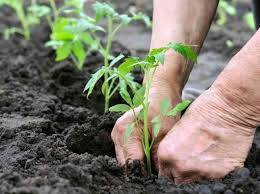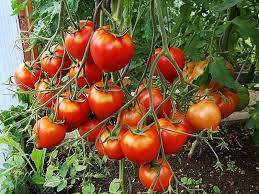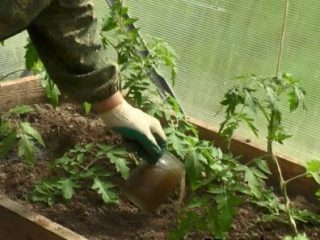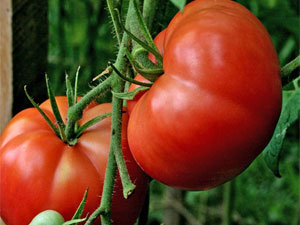Content
Some hybrid varieties of tomatoes have long been time-tested and are still popular among vegetable growers. These include the Budenovka tomato. Description of the variety and reviews indicate its excellent characteristics.
Every gardener who has at least once planted a Budenovka tomato on his plot was captivated by its excellent agrotechnical and nutritional qualities.
Description of the variety
In their taste and appearance, Budenovka tomatoes resemble the well-known variety Bull's Heart. Their bushes are not standard, they have a powerful root system with a diameter of about 0.5 m and are characterized by the absence of growth points - under favorable conditions and the absence of restrictions, the stems of the Budenovka tomato can grow up to 3-4 m. Therefore, their tops should be pinched.
The distinctive qualities of the hybrid variety Budenovka are:
- thin tall stem up to 1-1.5 m, which requires garter;
- a small number of tomato-type leaves and a characteristic dark green color;
- early fruit ripening - approximately 110 days;
- high resistance to common tomato pathologies;
- depending on the climatic conditions of the region, the Budenovka tomato can be grown in open ground or in greenhouses;
- the variety is unpretentious to growing conditions and produces high yields even in rainy seasons;
- The yield from 1 tomato bush, on average, can be approximately 5-7 kg.
Fruit characteristics
The fruits of the Budenovka variety acquire an appetizing pink-red color after ripening. They begin to ripen in open ground by the end of July, and they need to be picked already in the ripeness phase, since by this time the tomatoes inside are fully ripe. Their shape is heart-shaped, round, with an elongated nose, reminiscent of the famous headdress of the Red Army soldiers, which is where the name of the Budenovka variety comes from.
The fruits are large, their diameter reaches 15 cm, and their weight is on average 300 g, although sometimes it can be more. Despite their large size, tomatoes do not crack, retain their shape well during transportation and have good shelf life:
The Budenovka tomato, as evidenced by the characteristics and description of the variety, is universal in use - it is indispensable for fresh summer salads, for winter preparations, and for fresh freezing. Its excellent taste is noted - sweet juicy pulp with a slight sourness. And the rich mineral composition makes the Budenovka variety an essential component in dietary nutrition. With regular consumption of tomatoes:
- cholesterol levels in the blood decrease;
- blood pressure is normalized;
- the functioning of the digestive system improves.
Getting seeds from your garden
To grow the Budenovka tomato variety, it is recommended to collect the seeds yourself. To obtain high-quality seeds you need:
- without removing from the bush, bring the largest and healthiest tomato fruit to full ripening;
- remove the pulp with seeds and fill it with water in a glass container;
- after a week, when the mixture sours in a warm place, the tomato seeds will float to the surface;
- they need to be washed, placed on a clean napkin and dried in a dry, ventilated place;
- For storing seeds, a glass container that can be hermetically sealed is best suited - it should be filled halfway.
Sowing seeds for seedlings
Sowing of Budenovka tomato seeds for seedlings is carried out in March-April, depending on local climatic conditions. But tomato seedlings can be transplanted into open ground only after 1.5-2 months, after the night frosts have gone. The seedlings must first be hardened off gradually.
Before sowing, it is necessary to cull the seeds, first by visual means. Then pour them into a 1.5 percent solution of table salt. Poor quality seeds float, while healthy ones settle to the bottom. They are washed and disinfected in a weak solution of potassium permanganate. It is also recommended to soak tomato seeds in a growth stimulator. After this, you can plant it in preheated and disinfected soil, deepening it by about 2 cm.
To germinate seeds faster, some gardeners resort to a little trick - placing tomato seeds in a damp cloth for several days. There is another way to speed up the development of seeds - cover them after sowing and watering with glass or plastic wrap for several days. As soon as the seedlings hatch, you need to remove the film.
Planting and watering
When the first cluster of color appears on the seedlings, the tomatoes can be transplanted into separate holes. The Budenovka tomato variety loves fertile soils, so it is better to plant it in beds where zucchini, parsley, and carrots previously grew. You need to add a small handful of humus to each hole. The preferred planting pattern is checkerboard. Tomato seedlings can be planted at a distance of 30-35 cm from each other, and a gap of more than 0.5 m can be left between the rows.
The optimal watering regime is 2 times a week until flowering and ovary formation. Later, watering Budenovka tomatoes is reduced to once a week. After watering, you need to loosen the soil around the bushes and tear off excess lower leaves.
Methods for increasing yield
There are various ways in which you can increase the yield of Budenovka tomato. Reviews from gardeners indicate such techniques as:
- timely removal of stepsons from the leaf axils, which take a significant share of nutrients from the plant;
- pinching the main root when planting seedlings to stimulate the formation of lateral roots that can provide the bush with a sufficient amount of nutrients;
- pruning lateral roots contributes to the formation of a stronger root system and improved nutrition of the upper part of the tomato;
- pinching the top of the central stem stimulates the growth of lateral branches and an increase in the number of fruiting shoots;
- timely removal of excess leaves that shade the bushes due to too small a distance between them helps to increase the degree of illumination and the efficiency of the photosynthesis process;
- tapping the tomato stem during flowering helps complete pollination and ovary formation;
- By the end of the season, removing flowers from the stem that have not yet formed an ovary reduces the consumption of food on them.
Care technology
Characteristics and reviews indicate that the main disadvantage of the Budenovka tomato is that the stems are too thin. They will break easily under the weight of the fruit. Therefore, gartering of bushes is necessary. Otherwise, the technology for caring for Budenovka tomatoes is quite simple:
- the first fertilizing is carried out during the flowering period of plants;
- the next feeding should be carried out during the formation of the ovaries in order to provide the tomato with the nutrition necessary for fruiting;
- It is recommended to fertilize tomatoes of the Budenovka variety with infusions of herbs with wood ash, humus, potassium and phosphorus salts;
- They should be watered at the root, avoiding water getting on the foliage;
- by mulching tomatoes with compost, you can maintain a sufficient level of moisture under the bushes; to allow oxygen to reach the roots, periodically loosen the soil under the tomatoes and clear it of weed;
- Approximately once a week, carry out preventive spraying of Budenovka tomato with garlic infusions or other disinfectants.
There are other varieties of tomatoes that are distinguished by their ease of care, excellent taste and early ripening, for example, tomato variety Sevruga. The difference between the Budenovka tomato and Sevruga is that the latter is not a hybrid variety, and its fruits can reach 1 kg.
Reviews
In fact, the Budenovka variety has no negative reviews. All summer residents speak of it as a universal variety that combines a lot of positive characteristics.
Conclusion
It’s not for nothing that the Budenovka tomato variety is so popular, and its seeds are shared among summer residents. It fully corresponds to its description and reviews from gardeners.


















